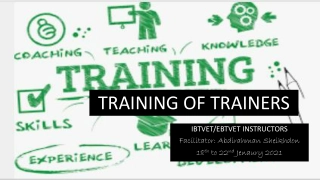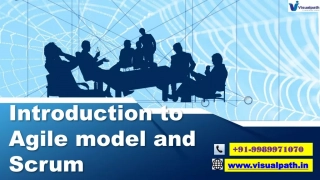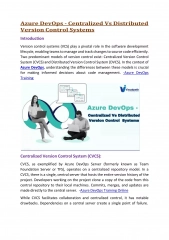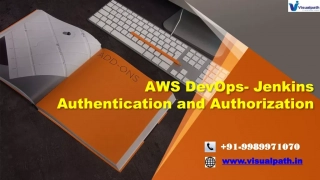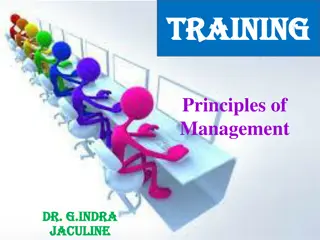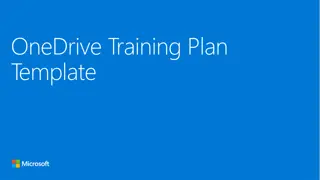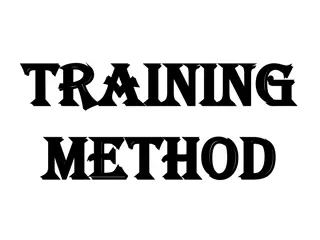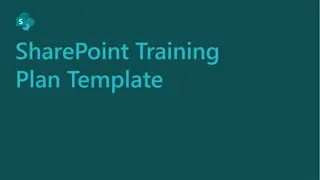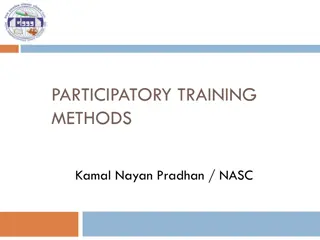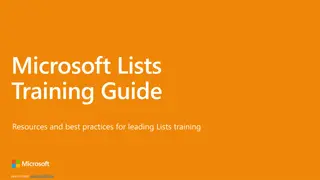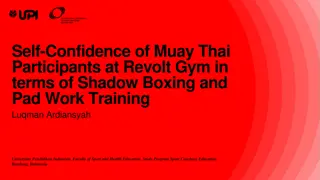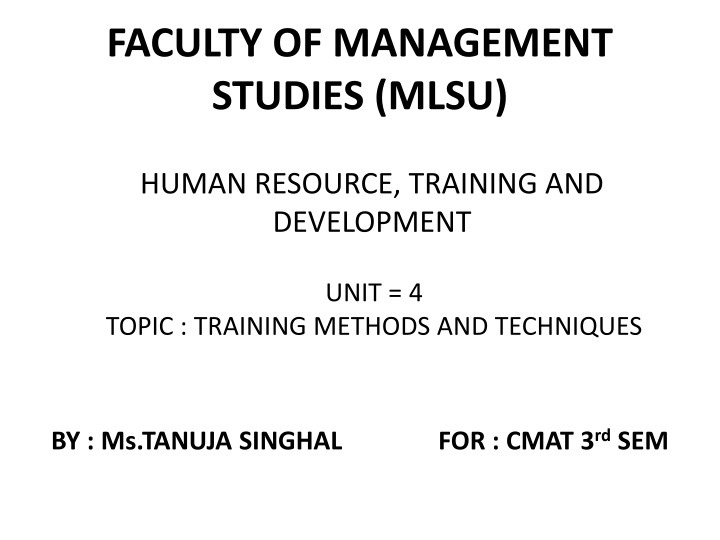
Training Methods and Techniques in Human Resource Development
Explore various training methods and techniques in human resource development, including technology-based learning, simulators, on-the-job training, coaching/mentoring, and more. Understand how these methods benefit employee learning and development in different industries.
Download Presentation

Please find below an Image/Link to download the presentation.
The content on the website is provided AS IS for your information and personal use only. It may not be sold, licensed, or shared on other websites without obtaining consent from the author. If you encounter any issues during the download, it is possible that the publisher has removed the file from their server.
You are allowed to download the files provided on this website for personal or commercial use, subject to the condition that they are used lawfully. All files are the property of their respective owners.
The content on the website is provided AS IS for your information and personal use only. It may not be sold, licensed, or shared on other websites without obtaining consent from the author.
E N D
Presentation Transcript
FACULTY OF MANAGEMENT STUDIES (MLSU) HUMAN RESOURCE, TRAINING AND DEVELOPMENT UNIT = 4 TOPIC : TRAINING METHODS AND TECHNIQUES BY : Ms.TANUJA SINGHAL FOR : CMAT 3rd SEM
1. TECHNOLOGY-BASED LEARNING Common methods of learning via technology include: Basic PC-based programs Interactive multimedia - using a PC-based CD-ROM Interactive video - using a computer in conjunction with a VCR Web-based training programs The forms of training with technology are almost unlimited. A trainer also gets more of the learner''s involvement than in any other environment and trainees have the benefit of learning at their own pace. Example: In the trucking industry one can imagine interactive multimedia training on tractor-trailers followed by a proficiency test to see how well the employee knows the truck.
2. SIMULATORS Simulators are used to imitate real work experiences. Most simulators are very expensive but for certain jobs, like learning to fly a 747, they are indispensable. Astronauts also train extensively using simulators to imitate the challenges and micro-gravity experienced on a space mission. The military also uses video games (similar to the "shoot-em-up" ones your 14-year old plays) to train soldiers. Example: Truck drivers could use simulators to practice responding to dangerous driving situations.
3. ON-THE-JOB TRAINING Jumping right into work from day one can sometimes be the most effective type of training. Here are a few examples of on-the-job training: Read the manual - a rather boring, but thorough way of gaining knowledge of about a task. A combination of observation, explanation and practice. Trainers go through the job description to explain duties and answer questions. Use the intranet so trainees can post questions concerning their jobs and experts within the company can answer them. On-the-job training gives employees motivation to start the job. Some reports indicate that people learn more efficiently if they learn hands-on, rather than listening to an instructor. However, this method might not be for everyone, as it could be very stressful.
Example: New trucking employees could ride with experienced drivers. They could ask questions about truck weigh stations, proper highway speeds, picking up hitchhikers, or any other issues that may arise.
4. COACHING/MENTORING Coaching/mentoring gives employees a chance to receive training one-on-one from an experienced professional. This usually takes place after another more formal process has taken place to expand on what trainees have already learned. Here are three examples of coaching/mentoring: Hire professional coaches for managers Set up a formal mentoring program between senior and junior managers Implement less formal coaching/mentoring to encourage the more experienced employees to coach the less experienced. Coaching/mentoring gives trainees the chance to ask questions and receive thorough and honest answers - something they might not receive in a classroom with a group of people.
Example:Again, truck drivers could gain valuable knowledge from more experienced drivers using this method.
5. LECTURES Lectures usually take place in a classroom-format. It seems the only advantage to a lecture is the ability to get a huge amount of information to a lot of people in a short amount of time. It has been said to be the least effective of all training methods. In many cases, lectures contain no form of interaction from the trainer to the trainee and can be quite boring. Studies show that people only retain 20 percent of what they are taught in a lecture. Example: Truck drivers could receive lectures on issues such as company policies and safety.
6. GROUP DISCUSSIONS & TUTORIALS These most likely take place in a classroom where a group of people discuss issues. For example, if an unfamiliar program is to be implemented, a group discussion on the new program would allow employees to ask questions and provide ideas on how the program would work best. A better form of training than lectures, it allows all trainees to discuss issues concerning the new program. It also enables every attendee to voice different ideas and bounce them off one another. Example: Truck drivers could have group discussions and tutorials on safety issues they face on the road. This is a good way to gain feedback and suggestions from other drivers.
7. ROLE PLAYING Role playing allows employees to act out issues that could occur in the workplace. Key skills often touched upon are negotiating and teamwork. A role play could take place between two people simulating an issue that could arise in the workplace. This could occur with a group of people split into pairs, or whereby two people role play in front of the classroom. Role playing can be effective in connecting theory and practice, but may not be popular with people who don t feel comfortable performing in front of a group of people.
7. ROLE PLAYING Example: Truck drivers could role play an issue such as a large line-up of trucks is found at the weighing station and one driver tells another that he might as well go ahead and skip the whole thing. Or role play a driver who gets pulled over by a police officer and doesn t agree with the speeding charge.
8. MANAGEMENT GAMES Management games simulate real-life issues faced in the workplace. They attract all types of trainees including active, practical and reflective employees. Some examples of management games could include: Computer simulations of business situations that managers play . Board games that simulate a business situation. Games surrounding thought and creativity - to help managers find creative ways to solve problems in the workplace, or to implement innovative ideas. Example: In a trucking business, managers could create games that teach truckers the impact of late deliveries, poor customer service or unsafe driving.
9. OUTDOOR TRAINING A nice break from regular classroom or computer-based training, the usual purpose of outdoor training is to develop teamwork skills. Some examples include: Wilderness or adventure training - participants live outdoors and engage in activities like whitewater rafting, sailing, and mountain climbing. Low-impact programming - equipment can include simple props or a permanently installed "low ropes" course. High-impact programming - Could include navigating a 40- foot "high ropes" course, rock climbing, or rappelling.
9. OUTDOOR TRAINING Outgoing and active participants may get the most out of this form of training. One risk trainers might encounter is distraction, or people who don t like outdoor activities. Example:As truck drivers are often on the road alone, they could participate in a nature-training course along with depot personnel to build esprit de corps.
10. FILMS & VIDEOS Films and videos can be used on their own or in conjunction with other training methods. To be truly effective, training films and videos should be geared towards a specific objective. Only if they are produced effectively, will they keep the trainees attention. They are also effective in stimulating discussion on specific issues after the film or video is finished. Films and videos are good training tools, but have some of the same disadvantages as a lecture - i.e., no interaction from the trainees.
10. FILMS & VIDEOS A few risks to think about - showing a film or video from an outside source may not touch on issues directly affecting a specific company. Trainees may find the information very interesting but irrelevant to their position in the company. Some trainers like to show videos as a break from another training method, i.e. as a break from a lecture instead of a coffee break. This is not a good idea for two reasons. One: after a long lecture, trainees will usually want a break from any training material, so a training film wouldn t be too popular. Two: using films and videos solely for the purpose of a break could get expensive. Example: Videos for truckers could show the proper way to interact with customers or illustrate preventive maintenance techniques.
11. CASE STUDIES Case studies provide trainees with a chance to analyze and discuss real workplace issues. They develop analytical and problem-solving skills, and provide practical illustrations of principle or theory. They can also build a strong sense of teamwork as teams struggle together to make sense of a case. All types of issues could be covered - i.e. how to handle a new product launch. Example: Truck drivers could use case studies to learn what issues have been faced in the trucking industry in the past and what they could do if a similar situation were to occur.
12. PLANNED READING Basically planned reading is pre-stage preparation to more formal methods of training. Some trainees need to grasp specific issues before heading into the classroom or the team-building session. Planned reading will provide employees with a better idea of what the issues are, giving them a chance to think of any questions beforehand. Example: Here we may be stretching if we think that truckers are going to read through a lot of material the training department sends them.
TRAINING TECHNIQUES So you ve got all the skills and characteristics needed to conduct your employee training. You know you are an excellent communicator, very well organized and that you possess significant knowledge about the industry. However, regardless of your qualities, if you use the same training techniques for trainers that are outdated and clich , the feedback from your trainees will not be desirable. So how do you adapt to different audiences, and how do you choose techniques that best fit the company you re training? Here are nine golden training tips for corporate trainers, to help you level up your game:
GET TO KNOW YOUR TRAINEES The number one, golden rule. It does not matter if you are the most articulate trainer in this industry, without knowing the audience you re targeting, all of your investment in the training can go to waste. Why does it matter? Because people have different ways of catching up on information. Some are visual learners, and they will remember what they see instead of what they hear. Some are night learners, learners through media usage, or learners that would appreciate your face to face input. Others may be Kinaesthetic learners, the ones that need to do things in order to learn. Knowing and admitting the difference in their learning styles is crucial and determines the efficiency of the training.
PLAN AHEAD Every idea has a concept. Your training sessions should have one too. Before the day of the training comes, make sure you re not going to be jumping all over the place with one information not matching with the over. This scenario can create confusion to your trainees, and although you may be a master at improvising, you may decrease the retention rate on your training. Remember that one of the essential skills of effective trainers is being organized; therefore, you need to rely on your practical techniques in this sense of order as well. Make sure you have a training calendar or a session plan, earlier on. Consider the fact that people are investing time and money, and they have high expectations on the equipment or behavioral changes you re about to provide them with.
ACTIVE TRAINING APPROACH By using the Active training approach, you can engage learners directly in the training process. This technique is known as the best practical benefit for learners. That s because through it, they are in charge of their learning, by following lessons that are opened for interpretation. Getting your trainees more involved means that you have to practice case study reviews, quizzes, demonstrations, group discussions, and workshops. The point is that you have to get them talking by enhancing their critical thinking skills as well. This technique is mostly learner-centric, although it still needs the trainer to facilitate the process of interacting. It empowers communication and group development by defeating the traditional concept of training through lecturing.
EXPERIENTIAL TRAINING APPROACH This approach is highly connected to the Actively training technique. Except that through Experiential training or hands- on training, as it is sometimes referred to, you also want to get your trainees involved in doing what they have been taught. You want them to practice their learned skills in their daily work environment. Four more concrete techniques that trainers use through experiential learning are: Onboard training Mentoring Role plays Simulations
EXPERIENTIAL TRAINING APPROACH The key to effective simulations and role-plays is to picking up real situations from work. Whereas in mentoring, you might want to assign older employees to assist new hires. Each of these methods requires commitment and genuine engagement from the employees, and it s an ideal situation where you can evaluate the success of your training so far. Also, you can take notes on where you need to narrow down your focus.
QUESTIONS You might be thinking why didn t we simply merge this as one of the trainer s tips within the previously elaborated techniques. That is because we do not want to undermine the importance of asking the proper questions, and actually waiting for relevant answers. Thinking is not driven by answers but by questions. a quote from The art of Socratic questions , a book by Dr. Richard Paul and Dr. Linda Elder. Good trainers know that questions encourage discussions and creativity. They increase knowledge and support trainees memory. But most of all, they promote a good feeling of recognizing one another s diverse opinions. Using the questions technique, you will impact and reinforce all the bits of information that the group is trying to digest.
Learning Management Systems (LMS) Diving into this perfect and innovative way to distribute educational courses. Learning management systems are one of the most efficient training tools for trainers. Through LMS, you can identify gaps, gather relevant data on trainees, and you can use different authoring tools to make the whole training process much more effective. However, probably the most important quality of using an LMS is that you let learners be in control of their learning, 27/7. They develop a self-paced technique, with more freedom to take their time or fasten up courses, based on their learning style. Considering all these LMS assets, it is important to choose your LMS platform carefully, taking into account its user-friendly features, pricing, and customer support.
VIDEO TRAINING Videos are no longer viewed as an entertainment purpose only. On a study conducted by Brandon Hall Group, 95 % of companies use videos for learning purposes. It s an exciting trend, and it can include many interactive, fun tools to keep the audience fully engaged. You can live stream your video along with the subject matter online through your LMS platform. Why videos? Because they are always accessible and available and can be used as refreshers whenever people want to go back to the content they have learned. Specifically, if you make them accessible through a variety of devices such as smartphones and tablets. Videos will directly increase employees productivity and will breakdown any complicated information you have prepared for them. And if you re wondering what makes a good video, then these are the essentials:
VIDEO TRAINING Understanding of the audience Visually engaging Clear and concise Organized Good lighting Good editing Excellent audio
GAMIFIED LEARNING On our previous article on the importance of gamification, we have defined it as the concept of applying game-design thinking to non-game applications. What is of highlighted importance in using games to learn is the level of reflection they can provide. Of course, productivity is predicted because you re mixing elements of competition, achievement, and fun. However, gamification also allows you to break down skills that have been performed throughout the game. Say, if an employee had a difficult time on the stages of the game that involved critical thinking and problem-solving skills, you as a trainer can take notes and mark your further areas of training investment. Overall said, employees, will be able to experiment on strategies and possible solutions to a problem, without the pressure of performing perfectly because after all, it is a game they re doing.
BLENDED LEARNING It is indeed difficult to tailor your training features according to individual preferences. That requires a decent needs analysis conducted first, and a detailed look upon your audience. The good thing is that you can actually enjoy the benefits of each employee training method by using blended learning.

